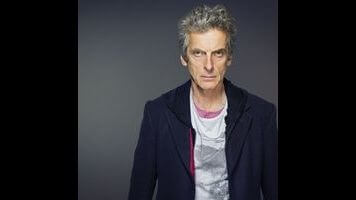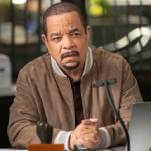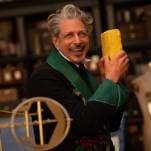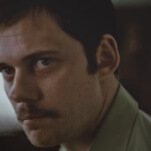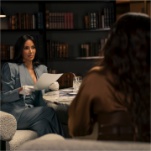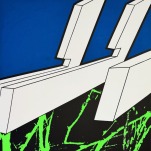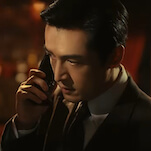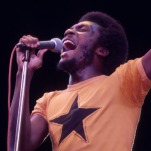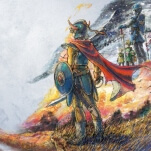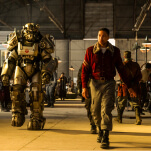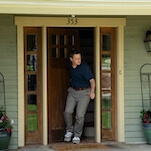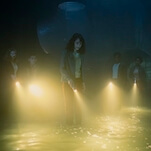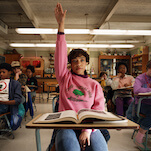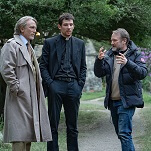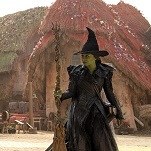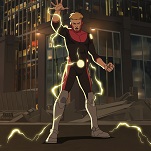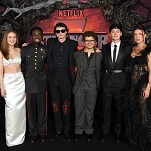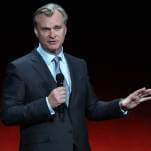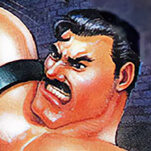“Oxygen” should have been a two-parter.
Some care is required when throwing around that suggestion, as I suspect the same has been said of every last single-episode story since Doctor Who’s return. After all, the logic can cut both ways: A bad episode could surely have been saved if it just had more time to develop its ideas, while an already good story could reach that next level if it had that extra room to expand and dig deeper. But there’s a difference between a story needing more time—maybe 60, maybe 75, or some other length Doctor Who doesn’t really do outside finales and Christmas specials—and one that could legitimately work as a two-part story, with a major cliffhanger or narrative shift in the middle signaling an organic dividing point. And hey, “Oxygen” has the perfect candidate for that with the reveal of the Doctor’s blindness, which admittedly the episode does immediately reuse as a teaser for next week’s otherwise unrelated story.
But let’s not make this about rewriting the episode, as that isn’t my job. Let’s instead look at it this way: “Oxygen” is one of those episodes that gets better on a rewatch, which isn’t unusual for Doctor Who episodes. I first wrote about this way back in my review of “Nightmare In Silver.” In that instance, the rewatch argument was perhaps more generous than that episode really deserved: Knowing the strengths and weaknesses of that story ahead of time made it easier to focus on the good bits and ignore the bad ones. “Oxygen,” on the other hand, doesn’t have nearly as many weaknesses to be excused, but a second viewing is helpful in appreciating just how much Jamie Mathieson managed to cram into this episode.
Throwaway details and moments connect together when a viewer knows what to look for, and his big critique of capitalism is more layered than it might initially appear when you can take the story as read and ponder the deeper meaning of the dialogue. A big takedown of capitalism’s excesses feels about as relevant now as it’s ever likely to be, and the notion of a company selling its workers oxygen is a brilliantly sadistic vision of the future of corporate excess. Doctor Who has gone in for this kind of political satire before—the classic-era stories “The Sun Makers” and “The Happiness Patrol” spring immediately to mind, as do Peter Harness’ controversial efforts from the past couple seasons—and those tend to be most successful when the show doesn’t bother with subtlety.
“Oxygen” too is at its best when it is straightforward, verging on over the top—the Doctor’s line about fighting an algorithm is great, as is the immediate follow-up about how they’re fighting the suits—but there are other, subtler critiques threaded throughout the episode that pass by so quickly they don’t quite register as part of a larger message. Which, admittedly, some people might like, as I can understand an aversion to preachiness. But I figure if you’re going to make part of the episode’s purpose exploring the evils of capitalism, there’s not much sense in underplaying one’s hand.
Basically, tonight’s episode is dense to the point of overstuffed. The guest characters all get the thumbnail sketch of a character arc. Abby goes from believing in the bosses and distrusting the Doctor to giving her approval for him to open the doors to the suits and take their revenge on the system. Ivan loses his partner Ellie in the pre-credits sequence, but you’d be forgiven for thinking that man was a different character when he doesn’t acknowledge that loss again until Ellie’s suit gives him her surplus oxygen at the end. The presence of the blue-skinned Dahh-Ren sets up a potentially fun bit of business with Bill’s accidental space racism, but the episode only has time to get in a couple quick jokes and move on. Then there are the side details about the future of capitalism. Tasker’s mention of the mythical union is a fun indicator of how the last vestiges of labor protection have degraded into the stuff of legend, but again the episode can’t do anything more with this than mention it in passing.
And yet, all this stuff is in there, waiting to be brought out. “Oxygen” has the makings of a legitimately great episode compressed to the point that it’s stuck closer to very good. It’s hard to fault a television episode its overambition, least of all an episode of Doctor Who. There are few false notes to be had here, with one exception I’ll get to presently. This is by far the best-looking excursion into space the show has had, with director Charles Palmer—returning to the show for the first time since directing “Human Nature”/“The Family Of Blood” a full decade ago—creating an impressive vision of the void and weightlessness of space on a British TV budget. Peter Capaldi and Pearl Mackie are as reliably great as ever, even if the latter doesn’t get as much to do here as she has in the first four episodes, while Matt Lucas and the guest cast all do good work in support. But when everything happens so fast—the decision to depict the spacewalk as Bill flits in and out of consciousness plays half as deliberate narrative decision, half as necessity to keep the story moving—not as many things register and land as well as they should.
In the early going, “Oxygen” has a more assured sense of its pacing. The Doctor’s longing for space and quarreling with Nardole make for a unique entry to the adventure, and the initial exploration of the seemingly deserted space station recalls the Fourth Doctor, Sarah Jane, and Harry making their way through the empty Nerva in first episode of “The Ark In Space,” which is always a good thing to recall. Nardole’s presence on a TARDIS trip offers some fresh dynamics for the show to explore, as he’s the rare companion—Jack Harkness and River Song are his only real new series rivals in this department—whose knowledge of the wider cosmos rivals that of the Doctor.
His early efforts are all built around convincing the Doctor to get back to the TARDIS as soon as possible, which surely has to be the most effective way to get the Doctor to stay right where he is—well, that along with the Doctor hearing his theme tune, otherwise known as a distress call. Unlike Bill or pretty much any other companion we’ve seen, Nardole’s interest is not in exploring or even necessarily in saving people, but rather in getting the Doctor back to the vault. Here again “Oxygen” could use with more time to expand and examine Nardole’s motivations during the middle part of the episode, where he’s mostly just along for the ride and the occasional provider of exposition and wisecracks, which makes his sudden sternness in the Doctor’s office at the end a bit of a shock. Which, sure, that’s effective and compelling in its own way, with the direction, writing, and performances all working to emphasize the abruptness of the shift. But that moment still feels of a kind with the generally rushed nature of the episode.
But the biggest issue with the episode, and the only thing I’d go so far as to call an actual weakness, is the monster. More specifically, the look of the monster, with the autonomous suits still carrying around frozen corpses. Now, that’s a brilliantly macabre concept, but it means the viewer can’t help but think of the episode’s threat as zombies, as the dead bodies inside the suits, rather than the suits themselves. There’s a way to thread that dehumanization into the broader critique of capitalism, and it’s sort of there if you squint, but not enough for the connection to be properly intuitive. After all, the episode’s punchline is the Doctor saying they are fighting the suits, which makes that particular visual counterproductive.
The zombies—which, sure, that’s not what they technically are, but it’s sure as hell what they look like, with Pearl Mackie in particular doing her best impression of a George Romero extra—also detract from what is meant to be another key idea of the episode, namely that space is dangerous and deadly in ways we rarely think about. That point is most effective when the show can function on bringing out real threats, like the lack of oxygen and pressure. The walking corpses push the danger back into less grounded, more classically Doctor Who territory, which undercuts some of the work Mathieson’s writing and Palmer’s direction do in making the cold void of space feel legitimately scary.
I’ve found plenty to critique in “Oxygen,” which is a pretty good indicator that there’s plenty there to discuss in the first place. Again, this episode is dense, and while it’s hard not to imagine how much more this story could be with more time to explore all of its dozens of ideas, the actual 45 minutes of Doctor Who that it exists does its best to work through all that material. The result isn’t as nimble or as impressive as “Thin Ice,” but the gap between those two stories will likely narrow the more one explores the ridiculous amount “Oxygen” has to offer.
Stray observations
- One of the great joys of rewatching this episode is studying how Peter Capaldi plays the scene in the TARDIS after the Doctor is supposedly cured of his blindness. He doesn’t make it obvious so as not to give away the twist, but he never quites fixes his focus on anyone he’s talking to, and he subtly holds onto the TARDIS console to steady himself.
- I only just realized this, because sometimes these things are just so stupidly obvious you miss them, but there’s particular brilliance to the Doctor quoting the Star Trek opening, given that show’s vision of a post-capitalist future. Again, this episode doesn’t lack for complexity. Also, Capaldi is one of the very few Doctors (or actors in general, really) I would trust to deliver that line without feeling compelled to wink at the audience in his reading. He is very, very good at what he does.
- No, but seriously, what does any of this have to do with crop rotation?
